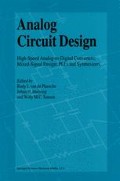Abstract
The continuously increasing chip density makes it now possible to integrate more functions and even a complete system on a single chip. Since a complete system contains analog and digital signal processing and is often controlled and supported by an embedded microcore, this evolution has favoured mixed signal chips, that combine these functions on a single chip. At the same time, mixed signal design itself has changed. In the eighties, the analog circuits dominated the area of the mixed signal chips. Nowadays, the situation is reversed and the digital circuits dominate the area. As a consequence, the design issues for mixed signal chips have changed accordingly. Three of these design issues are discussed below. The strong demand to use a digital technology for the mixed signal chip, the increased interference between digital and analog circuits and the concurrent design of analog, digital and embedded software for the mixed system-on-achip.
Access this chapter
Tax calculation will be finalised at checkout
Purchases are for personal use only
Preview
Unable to display preview. Download preview PDF.
References
K. Bult, “Analog Broadband Communication Circuits in Pure Digital Deep Sub-Micron CMOS”, “, ISSCC 1999, Digest of Technical Papers, Slide supplement, Paper MP 4. 6.
H. Samueli, “Broadband Communications ICs: enabling High-Bandwidth Connectivity in the Home and Office”, ISSCC 1999, Digest of Technical Papers, Slide supplement, Paper MA 1. 3.
H. Casier, “Mixed Design in a Digital CMOS Technology, Trade-offs and Case Study”, Proceedings of the IEEE CAS Workshop on Mixed-Signal Integrated Circuit Design MSICD, Long Beach 1999.
H. Yoshizawa, Y. Huang, P.F. Ferguson Jr. and G.C. Ternes, “MOSFET-Only Switched-Capacitor circuits in Digital CMOS Technology”, IEEE Journal of Solid-State Circuits, vol. 34 no. 6, June 1999.
D. Su, M. Loinaz, S. Masui and B. Wooley, “Experimental Results and Modeling Techniques for Substrate Noise in Mixed-Signal Integrated Circuits”, IEEE Journal of Solid-State Circuits, vol. 28 no. 4, April 1993.
B. Nauta and G. Hoogzaad, “Substrate Bounce in Mixed-Mode CMOS ICs”, Digest of Technical Papers, workshop on Advances in Analog Circuit Design, Copenhagen 1998.
D.W.J. Groeneveld, “Groundbounce in CMOS”, Digest of Technical Papers, workshop on Advances in Analog Circuit Design AACD, Leuven 1993.
M. Ingels, “CMOS Interface Circuits for Optical Communication”, Chapter 5, Electrical interferences in mixed-mode integrated circuits, Ph.D. dissertation, Katholieke Universiteit Leuven, March 2000.
T. Blalack and B. Wooley, “The effects of Switching Noise on an Oversampling A/D Converter”, ISSCC 1995 Digest of Technical Papers, pp 200–201.
W. Dehaene, “CMOS Integrated Circuits for Analog Signal Processing in Hard Disk Systems”, Paragraph 5. 5, Results for the filter and tuning system, Ph.D. dissertation, Katholieke Universiteit Leuven, November 1996.
J. Hendrickx, “MIDAS and Analog CAD at Philips”, Proceedings of the 2nd international Summer Course on Systematic Analog Design, Heverlee, Belgium, May 31, 1995.
ADMIR-x, Family of ADCs (10 to 16 bits) for measurement/sensor applications, Dolphin Integration, Grenoble France.
G. Gielen, H. Walscharts and W. Sansen, “ISAAC: a symbolic simulator for analog integrated circuits”, IEEE Journal of Solid-State Circuits, vol. 24 no. 6, December 1989.
J-O. Fischer-Binder, “Analog circuit sizing using CISE,” MEDEA/ESPRIT Conference on System-level Design, Antwerp, Belgium, September 1999.
R. Sommer, E. Hennig, M. Thole, T. Halfmann and T. Wichmann, “Symbolic Modeling and Analysis of Analog Integrated Circuits,” Proceedings of the European Conference on Circuit Theory and Design ECCTD, Stresa, Italy, September 1999.
CHARACTER, Automated Cells characterization, MIDI Ingenierie, Labege Innopole, France
Author information
Authors and Affiliations
Editor information
Editors and Affiliations
Rights and permissions
Copyright information
© 2000 Springer Science+Business Media New York
About this chapter
Cite this chapter
Casier, H.J. (2000). Mixed Signal Design — Design Issues —. In: van de Plassche, R.J., Huijsing, J.H., Sansen, W. (eds) Analog Circuit Design. Springer, Boston, MA. https://doi.org/10.1007/978-1-4757-3198-9_8
Download citation
DOI: https://doi.org/10.1007/978-1-4757-3198-9_8
Publisher Name: Springer, Boston, MA
Print ISBN: 978-1-4419-5002-4
Online ISBN: 978-1-4757-3198-9
eBook Packages: Springer Book Archive

